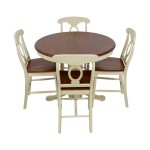White Wash Oak Kitchen Cabinets: A Comprehensive Guide
White wash oak kitchen cabinets represent a popular design choice for homeowners seeking a blend of rustic charm and modern aesthetics. The technique involves applying a diluted white paint or stain to oak wood, allowing the natural grain and texture to remain visible beneath the translucent layer. This creates a light, airy feel while retaining the warmth and character of the wood. The resulting effect is versatile, complementing a range of kitchen styles from farmhouse and country to contemporary and coastal.
The selection of white wash oak kitchen cabinets involves a careful consideration of several factors, including the type of oak, the specific whitening process, the hardware, and the overall design direction. Understanding these aspects is crucial for achieving the desired aesthetic and ensuring the longevity of the cabinets.
Understanding the Oak Wood
Oak is a hardwood prized for its durability, strength, and distinctive grain patterns. There are primarily two types of oak used in cabinet making: red oak and white oak. These species differ in their color, grain structure, and resistance to moisture.
Red oak, characterized by a reddish undertone, features a more open grain pattern. This makes it slightly more porous and susceptible to absorbing stains. While red oak can be effectively white washed, the grain's openness may require multiple coats or a specialized sealant to prevent excessive stain absorption, which could result in a pinkish hue underneath the white wash. It is often more cost-effective than white oak.
White oak, in contrast, exhibits a warmer, tan color and possesses a tighter, closed grain. This makes it more resistant to moisture and less prone to excessive stain absorption. As a result, white oak often yields a cleaner, more consistent white wash finish. Its tighter grain also provides a smoother surface, which can be preferable for certain design preferences. White oak does tend to be more expensive than red oak as a result.
The choice between red oak and white oak depends largely on the desired aesthetic and budget. Both species can be successfully white washed, but understanding their inherent differences is essential for achieving the desired outcome and mitigating potential issues during the finishing process. Considerations should also be made to the quality of the wood and whether it is solid oak or oak veneer, with solid oak offering superior durability and longevity.
The White Washing Process: Techniques and Materials
The white washing process involves several steps, each contributing to the final appearance of the oak cabinets. These steps generally include preparation, application, and sealing. The selection of materials and the specific techniques employed can significantly impact the results.
Proper preparation is paramount for achieving a smooth, even finish. This typically involves cleaning the wood surface to remove any dirt, grease, or existing finishes. Sanding the wood is crucial for creating a slightly rough surface that allows the white wash to adhere properly. The level of sanding will also impact how much of the wood grain is visible. Using a finer grit sandpaper will seal the grain further, allowing for a smoother finish. Coarser grit sandpaper will open the grain, giving a heavier texture.
The application of the white wash can be achieved using various methods, including brushing, spraying, or wiping. Brushing tends to create a more textured finish, emphasizing the grain patterns. Spraying provides a smoother, more uniform application. Wiping involves applying the white wash with a cloth and then immediately wiping off the excess, allowing the stain to settle into the grain. The choice of application method depends on the desired aesthetic and the type of finish chosen.
The choice of stain is also critical. Water-based stains tend to produce a softer, more translucent effect, while oil-based stains offer greater durability and water resistance. Chalk paints, often diluted with water, are another popular option for achieving a distressed, matte finish. The white wash can be applied in multiple coats to achieve the desired level of opacity. Thin coats are recommended to avoid obscuring the grain entirely. Experimentation on a sample piece of wood is essential to determine the optimal number of coats and the appropriate dilution ratio.
Sealing the white washed cabinets is vital for protecting the finish and enhancing its longevity. A clear topcoat, such as polyurethane or varnish, provides a durable, water-resistant barrier. The choice of sealant depends on the desired sheen level. Matte sealants create a more natural, understated look, while gloss sealants offer a higher level of shine and reflectivity. Multiple coats of sealant are typically recommended for added protection, with light sanding between coats to ensure a smooth, even surface.
Design Considerations for White Wash Oak Kitchens
White wash oak cabinets are remarkably versatile, complementing a wide range of kitchen styles and color palettes. However, careful consideration of design elements is essential for creating a cohesive and visually appealing space.
The selection of countertops plays a crucial role in complementing the white wash oak cabinets. Light-colored countertops, such as white quartz, marble, or light granite, can enhance the brightness and airiness of the kitchen. Butcher block countertops can add warmth and a rustic touch, creating a charming contrast with the white wash finish. Dark countertops, such as black granite or soapstone, can provide a dramatic counterpoint, creating a sophisticated and modern look. The edge profile of the countertop also contributes to the overall aesthetic. A simple, clean edge complements a contemporary design, while a more ornate edge suits a traditional style.
Hardware choices, including cabinet pulls, knobs, and hinges, can significantly impact the overall look and feel of the kitchen. Brushed nickel or stainless steel hardware offers a sleek, modern aesthetic. Black hardware provides a bold contrast against the white wash cabinets. Antique brass or bronze hardware adds a touch of vintage charm. The style of the hardware should align with the overall design direction of the kitchen. For a contemporary kitchen, minimalist hardware is often preferred. For a traditional kitchen, more ornate hardware may be more appropriate.
The color palette of the kitchen should also complement the white wash oak cabinets. Neutral colors, such as gray, beige, and cream, create a calming and harmonious atmosphere. Soft pastel colors, such as light blue, green, or lavender, can add a touch of whimsy and personality. Bold accent colors, such as navy blue, red, or yellow, can create visual interest and drama. The choice of paint colors for the walls, backsplash, and trim should be carefully coordinated to create a cohesive and balanced space. Incorporating natural materials, such as stone, wood, and plants, can enhance the organic feel of the kitchen.
Lighting plays a vital role in showcasing the beauty of the white wash oak cabinets. Natural light is ideal, but adequate artificial lighting is essential, especially in areas with limited natural light. Recessed lighting provides general illumination, while pendant lights and chandeliers add visual interest and task lighting. Under-cabinet lighting illuminates the countertops, enhancing functionality and safety. The color temperature of the lighting should be carefully considered. Warm lighting creates a cozy and inviting atmosphere, while cool lighting provides a brighter, more energizing feel.
Finally, the arrangement of the kitchen layout and the inclusion of architectural details should be considered. Open shelving can display decorative items and provide easy access to frequently used items. A kitchen island provides additional workspace and storage. Crown molding adds a touch of elegance and sophistication. Tile backsplashes can add color, texture, and visual interest. Sink choice and faucet style can be tailored to any design style and provide a functioning element that ties the room together.
By carefully considering these design elements, homeowners can create a stunning and functional kitchen that showcases the timeless beauty of white wash oak cabinets.

White Washed Oak Cabinets Dodored

White Kitchen Cabinets Are They Still In Style Packard Cabinetry

Antique Kitchens Pictures And Design Ideas

White Washed Oak Cabinets Dodored

White Washed Kitchen Island Design Ideas

Pictures Of Kitchens Traditional Whitewashed Cabinets

Whitewash Store Oak Cabinets

White Washed Oak Cabinets Dodored

Whitewashed Cabinet Makeover Confessions Of A Serial Do It Yourselfer

25 Best Collection Whitewash Oak Cabinets Home Decor And Garden Ideas








